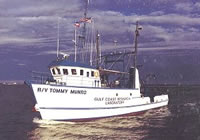Other ID: none
Status: Completed
Organization(s): USGS, Woods Hole Coastal and Marine Science Center
Funding Program(s):
Principal Investigator(s): David Twichell
Affiliate Investigator(s):
Information Specialist(s): Elizabeth Pendleton
Data Type(s): Sonar: Interferometric, Location-Elevation: Navigation, Seismics: Sub Bottom Profiler, Sonar: Sidescan, Sonar: Sound Velocity
Scientific Purpose/Goals: High-resolution seismic, swath bathymetry, and sidescan sonar mapping of the inner shelf off the Mississippi Barrier islands to map the geologic framework and assess the extent of offshore sand deposits.
Vehicle(s):
Start Port/Location: Biloxi, MS
End Port/Location: Biloxi, MS
Start Date: 2010-03-01
End Date: 2010-03-17
Equipment Used: HYPACK, Klein 3000, Sensor - SVP, SEA SWATHplus-M 234 kHz, Edgetech chirp subbottom profiler 512i
Information to be Derived:
Summary of Activity and Data Gathered: A cruise aboard the R/V TOMMY MUNRO was conducted March 1-17, 2010 by the Woods Hole Science Center. The purpose of the cruise was to collect swath bathymetry, sidescan sonar imagery and high-resolution chirp seismic profiles to define the sea floor morphology and the shallow stratigraphy of the inner shelf offshore of a string of barrier islands in the northern Gulf of Mexico along the Mississippi coast. The scientific goals of the project were twofold: 1) to better understand the geologic evolution of this coastal region, and 2) to provide stratigraphic information to the U.S. Army Corps of Engineers for an assessment of sand resources that they are compiling for the region. The cruise was hampered by less-than-ideal weather conditions. Data were collected during the following days: 3-9 March, 11-12 March, 14-16 March. During the cruise seismic data were collected along 1778 km of survey tracklines, swath bathymetry along 1418 km of survey tracklines, and sidescan imagery along 1332 km of survey tracklines. Preliminary processing was completed in the field on all three data types. The quality of the chirp and bathymetry data was excellent. During the initial part of the cruise, the sidescan imagery was of inferior quality because of ship noise. The location of the sidescan vehicle was moved from the port side to the stern of the ship during the first port call, and the quality improved significantly. For the lower quality imagery, processing procedures were modified to minimize the ship noise.
Staff: Wayne Baldwin, Emile Bergeron, William Danforth, David Foster, Elizabeth Pendleton, Aaron Turecek, Charles Worley
Affiliate Staff:
Dana Wiese
USGS-St. Petersburg
Notes:
Location:
Gulf of Mexico, North America, North Atlantic,
| Boundaries | |||
|---|---|---|---|
| North: 30.26856 | South: 30.07147 | West: -89.0085 | East: -88.38501 |
Platform(s):
 Tommy Munro |
Flocks, J.G., Kindinger, J.L., Kelso, K.W., 2015, Geologic control on the evolution of the inner shelf morphology offshore of the Mississippi barrier islands, northern Gulf of Mexico, USA: Continental Shelf Research, v. 101, pp. 59–70, doi: 10.1016/j.csr.2015.04.008.
Pendleton, E.A., Baldwin, W.E., Danforth, W.W., DeWitt, N.T., Foster, D.S., Forde, A.S., Kelso, K.W., Pfeiffer, W.R., Turecek, A., Flocks, J.G., Twichell, D.C., 2011, Geophysical data from offshore of the Gulf Islands National Seashore, Cat Island to western Horn Island, Mississippi: U.S. Geological Survey Open-File Report 2010-1178, https://doi.org/10.3133/ofr20101178.
Twichell, D.C., Pendleton, E.A., Flocks, J.G., Baldwin, W.E., Foster, D.S., 2011, The shallow stratigraphy and sand resources offshore of the western part of the Mississippi barrier islands: U.S. Geological Survey Open-File Report 2011-1173, https://doi.org/10.3133/ofr20111173.
Pendleton, E.A., Baldwin, W.E., Danforth, W.W., Dewitt, N.T., Foster, D.S., Forde, A.S., Kelso, K.W., Pfeiffer, W.R., Turecek, A., Flocks, J.G., and Twichell, D.C., 2011, Geophysical data from offshore of the Gulf Islands National Seashore, Cat Island to Western Horn Island, Mississippi: U.S. Geological Survey Open-File Report 2010-1178, https://doi.org/10.3133/ofr20101178.
Twichell, D.C., Pendleton, E.A., Flocks, J.G., Baldwin, W.E., and Foster, D.S., 2011, The shallow stratigraphy and sand resources offshore of the Mississippi Barrier Islands: U.S. Geological Survey Open-File Report 2011-1173, https://doi.org/10.3133/ofr20111173.
FAN 2010-012-FA has data viewable in the GeoMappApp/Virtual Ocean applications. To view this data in these applications go to http://www.geomapapp.org/ and http://www.virtualocean.org/. See the instructions for locating USGS data in these applications. You can also view the imagery created from the SEGY data at https://cmgds.marine.usgs.gov/images.php?cruise=2010-012-FA.
| Survey Equipment | Survey Info | Data Type(s) | Data Collected |
|---|---|---|---|
| HYPACK | --- | Navigation | 2010-012-FA-LN-001-01 (These raw navigation data are included as an archive documenting the survey area surrounding the Elizabeth Islands, Massachusetts and the instrumentation used to manage the ship's navigation.) 2010-012-FA-LN-001 (Hypack navigation data) |
| Klein 3000 | --- | Sidescan | 2010-012-FA-SO-001-01 (XSonar/ShowImage software was used to correct for geometric and radiometric distortions in the raw sidescan data (Danforth, 1997), and PCI Geomatica (version 10.1) software was used to create georeferenced mosaics of the final, processed data. Gray-scale GeoTIFF images of the mosaics were produced at 1-m resolution. Sidescan-sonar data were acquired along approximately 1,750 km of tracklines during the 2010 cruises, yielding a total mosaic area of about 260 km2.) |
| Sensor - SVP | --- | Sound Velocity | |
| SEA SWATHplus-M 234 kHz | --- | Interferometric | 2010-012-FA-BA-001-01 (CARIS (2010), a swath-bathymetry-processing software package, was used to post-process the bathymetric soundings. Sounding data were rectified for ship motion, and spurious soundings were eliminated. Corrections for sound velocity changes within the water column and tidal offsets (utilizing a NOAA discrete tidal zoning model and tidal observations from two Mississippi tide stations) were also applied to the soundings. Final soundings were referenced to mean lower low water (MLLW) vertical datum. Processed soundings from approximately 1,800 km of tracklines yielded a final bathymetric surface area of about 265 km2, which was gridded at a resolution of 50 m/pixel.) |
| Edgetech chirp subbottom profiler 512i | --- | Sub Bottom Profiler | 2010-012-FA-SE-001-01 (SIOSEIS (SIOSEIS, 2007), Seismic Unix (Stockwell and Cohen, 2010) and SeisVision (Halliburton, 2010) were used to postprocess the raw Chirp seismic-reflection data. Navigation data were inspected and edited, static corrections were applied to correct for fish depth beneath the sea surface, seafloor reflections were identified by peak amplitude, and sea-surface heave was removed. Final trace data, plotted as PNG images, and geo-located trackline files are presented in this report.) Chirp seismic data |